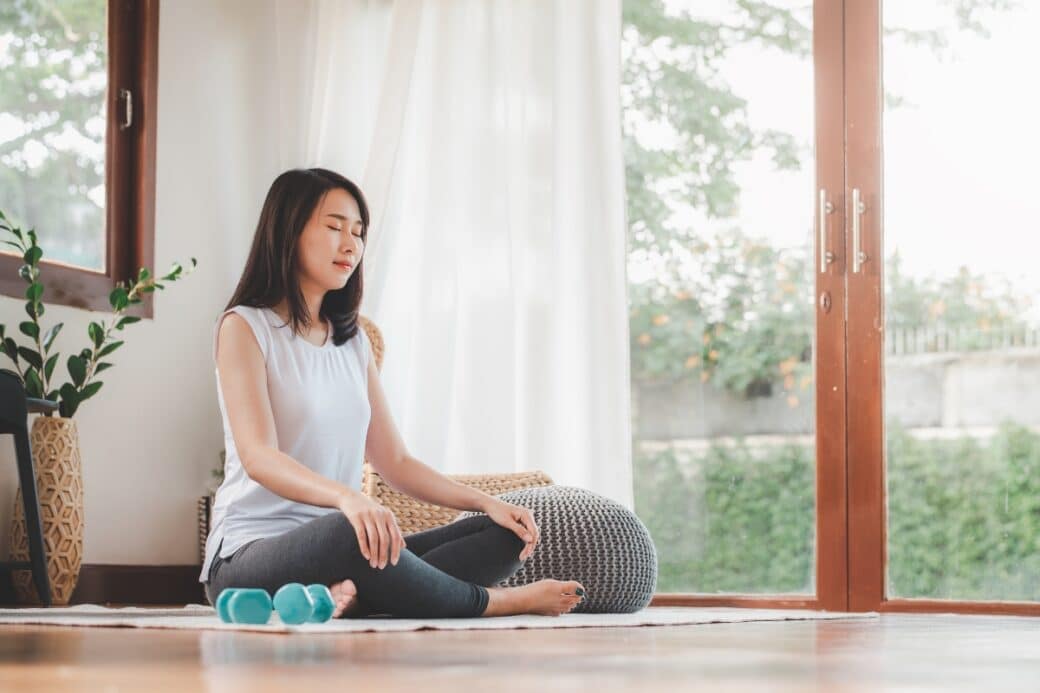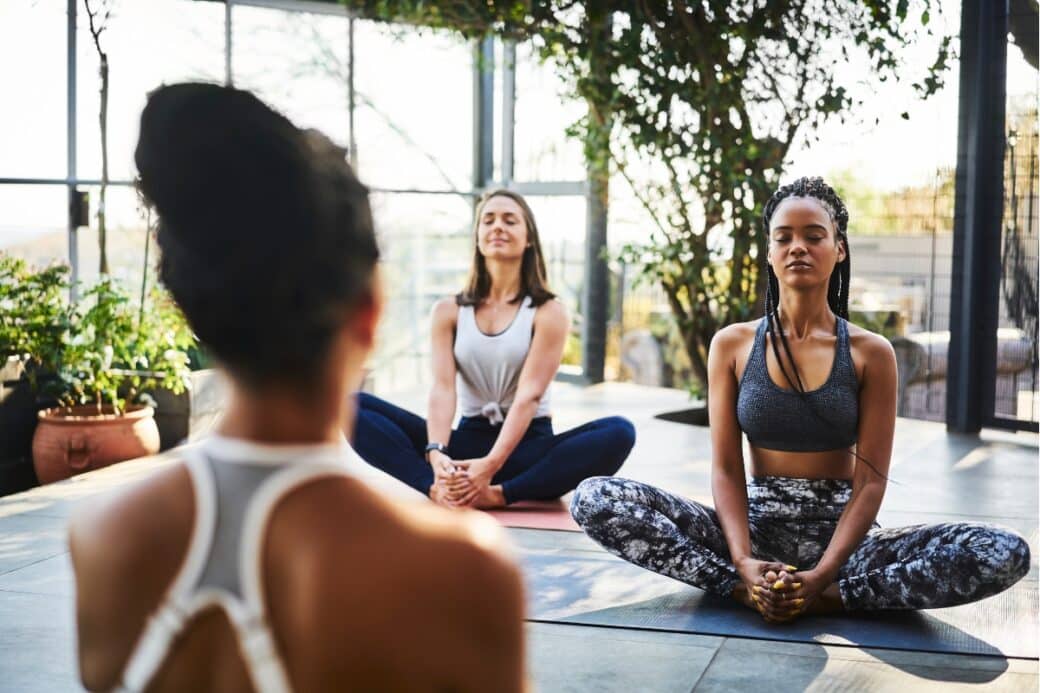Are you constantly battling with anxiety and seeking ways to find inner peace amidst the chaos? Look no further! In this article, we will explore the world of mindfulness exercises for anxiety, providing you with a plethora of techniques that can help soothe your mind and cultivate a sense of inner calm. From guided meditation to deep breathing exercises, these practices will empower you to take charge of your anxiety and unlock the power of mindfulness in your daily life. So, are you ready to embark on this journey towards serenity and tranquility? Let’s get started!

Understanding Mindfulness and Anxiety
Defining Mindfulness
Mindfulness is the practice of intentionally bringing your attention to the present moment and fully engaging in the experiences unfolding before you. It involves paying attention to your thoughts, feelings, sensations, and surrounding environment without judgment. Mindfulness allows you to cultivate a state of awareness and acceptance, enabling you to respond to life’s challenges with equanimity and clarity. By focusing your attention on the present moment, mindfulness helps you let go of worries about the past or future and find contentment in the here and now.
Exploring the Impact of Anxiety
Anxiety is a common emotional state characterized by feelings of fear, unease, and worry. It can manifest as physical symptoms such as increased heart rate, shortness of breath, and muscle tension. Anxiety can have a significant impact on daily life, making it difficult to concentrate, sleep, and engage in activities that once brought joy. Chronic anxiety also takes a toll on mental and emotional well-being, often leading to stress and a decreased sense of overall happiness. It is important to note that anxiety disorders, such as generalized anxiety disorder or panic disorder, may require professional medical attention and support.
The Connection between Mindfulness and Anxiety
Mindfulness and anxiety are interconnected in a unique and powerful way. Mindfulness exercises provide individuals with a valuable tool to address anxiety and its effects. By practicing mindfulness, you can cultivate self-awareness and develop a moment-to-moment understanding of your thoughts, emotions, and physical sensations. This increased awareness allows you to recognize anxiety-triggering patterns and respond to them with compassion and non-judgment. Mindfulness empowers you to observe anxious thoughts and feelings without becoming overwhelmed by them, ultimately helping to reduce anxiety’s grip on your life.
Benefits of Mindfulness Exercises for Anxiety
Reducing Stress Levels
One of the prominent benefits of mindfulness exercises for anxiety is stress reduction. Mindfulness practices, such as focused breathing or body scan meditations, activate the body’s relaxation response and help regulate the stress hormone cortisol. By regularly engaging in mindfulness, you can alleviate the physiological and psychological effects of stress, promoting a sense of calm and tranquility.
Improving Mental Focus
Anxiety often causes a scattered and restless mind, making it challenging to concentrate on tasks or stay present in the moment. Mindfulness exercises enhance mental focus by training the mind to anchor its attention to the present moment. With practice, you can develop the ability to direct your attention intentionally and sustain it on the task at hand, reducing anxiety-related distractions and improving overall productivity.
Promoting Emotional Well-being
Anxiety can lead to heightened emotional reactivity, causing individuals to become overwhelmed by intense emotions. Mindfulness exercises help cultivate emotional regulation by creating space between the stimulus and the response. By maintaining a non-judgmental awareness of your thoughts and emotions, you can develop greater resilience and learn to respond to challenging situations with more compassion, patience, and equanimity.
Enhancing Self-awareness
Self-awareness is a fundamental aspect of mindfulness, and it plays a crucial role in managing anxiety. Through mindfulness practices, you can gain insight into the thoughts, beliefs, and triggers that contribute to your anxiety. This self-awareness enables you to cultivate a compassionate understanding of yourself and make conscious choices that alleviate anxiety. By recognizing your patterns and tendencies, you can develop new, healthier ways of responding to anxiety-provoking situations.

Foundational Principles of Mindfulness
Concept of Present Moment Awareness
The concept of present moment awareness lies at the core of mindfulness. It involves intentionally directing your attention to the here and now, rather than dwelling on the past or worrying about the future. By fully immersing yourself in the present moment, you can experience a sense of groundedness and reduce the impact of anxious thoughts that often stem from anticipation or regret.
Non-judgmental Observation
Non-judgmental observation is a cornerstone of mindfulness practice. It entails acknowledging your thoughts, feelings, and sensations without labeling them as good or bad. Instead of engaging in self-criticism or judgment, you cultivate an attitude of curiosity and acceptance toward your experience. By observing without judgment, you create a space for self-compassion and eliminate the unnecessary burden of self-criticism.
Principle of Acceptance
Acceptance is a fundamental principle of mindfulness that involves embracing your experience as it is, rather than resisting or trying to change it. Acknowledging and accepting your thoughts, emotions, and physical sensations, including anxiety, allows you to promote inner peace and reduce suffering. Acceptance does not mean resignation or passivity; instead, it empowers you to respond to anxiety with understanding and kindness.
Understanding Impermanence
Impermanence is a concept that highlights the transient nature of everything in life. Mindfulness teaches us that our experiences, including anxiety, wax and wane, arising and passing away in their own time. By recognizing the impermanence of anxiety, you can develop a sense of perspective and resilience, knowing that it is not a permanent state. This understanding encourages you to stay present and allow anxiety to naturally dissolve.
Mindful Breathing as a Tool for Anxiety
Anatomy of Mindful Breathing
Mindful breathing involves directing your attention to the sensations of breathing, such as the rising and falling of the abdomen or the feeling of air passing through the nostrils. It serves as an anchor, helping to keep your attention in the present moment. By focusing on the breath, you cultivate a sense of calm and stability, allowing anxious thoughts to dissipate.
Steps to Practice Mindful Breathing
- Find a comfortable position, whether sitting or lying down, and close your eyes if it feels comfortable.
- Bring your attention to your breath, noticing the sensation of the breath entering and leaving your body.
- Follow the natural flow of your breath, without trying to control or manipulate it.
- If your mind wanders, gently and non-judgmentally bring it back to the breath, refocusing on the sensation of breathing.
- Continue this practice for a few minutes or as long as feels comfortable, gradually increasing the duration over time.
How Mindful Breathing Helps with Anxiety
Mindful breathing activates the body’s relaxation response, promoting a sense of calm and reducing anxiety. By directing your attention to the breath, you shift your focus away from anxious thoughts and bodily sensations, allowing them to lose their grip on your mind. Mindful breathing increases your awareness of the present moment and helps break the cycle of anxious rumination, enabling you to respond to anxiety with greater clarity and ease.
Tips for Establishing a Regular Mindful Breathing Practice
- Set aside dedicated time each day for mindful breathing, even if it’s just a few minutes.
- Choose a quiet and comfortable environment where you can minimize distractions.
- Use reminders such as an alarm, post-it notes, or smartphone apps to prompt you to practice mindfulness regularly.
- Start with shorter practice sessions and gradually increase the duration as your comfort and commitment grow.
- Be gentle and patient with yourself. If your mind wanders, simply notice it without judgment and gently bring your attention back to the breath.

Body Scan Meditation and Anxiety
Understanding Body Scan Meditation
Body scan meditation is a practice that involves systematically directing your attention to different parts of your body, noticing any physical sensations or areas of tension. It is a way of cultivating present-moment awareness and developing a friendly and non-judgmental relationship with your body. By bringing your attention to each body part, you can release tension and become more attuned to the signals your body is sending, allowing for a deeper sense of relaxation.
Guidelines for Performing a Body Scan Meditation
- Find a comfortable position, either lying down or sitting up straight, and close your eyes if it feels comfortable.
- Begin by bringing your attention to your breath, grounding yourself in the present moment.
- Slowly and systematically scan your body from head to toe, or vice versa, noticing any sensations or areas of tension as you go.
- When you encounter sensations, try to observe them without judgment or the need to change them.
- If you notice tension or discomfort, direct your breath and gentle attention to that area, allowing it to soften and release.
- Take your time and be patient with yourself. It’s okay if your mind wanders; simply bring your attention back to the body.
Impact of Body Scan Meditation on Anxiety
Body scan meditation is a powerful tool for managing anxiety as it helps shift your focus away from worrisome thoughts and redirects your attention to the present moment and the sensations in your body. Through this practice, you can become more attuned to the physical manifestations of anxiety, such as muscle tension, and learn to release them with each breath. Body scan meditation promotes relaxation, reduces feelings of stress, and allows you to develop a deeper sense of connection with your body.
Precautions and Considerations for Body Scan Meditation
While body scan meditation can be beneficial for many individuals, it is essential to practice it with care, especially if you have a history of trauma, body dysmorphia, or certain mental health conditions. If you find that body scan meditation triggers distressing emotions or sensations, it is advisable to seek guidance from a trained meditation teacher or mental health professional who can provide appropriate support and modifications. Remember that your well-being is paramount, and you should always prioritize your comfort and safety during meditation practice.
Yoga Techniques for Mindful Movement
Introduction to Yoga and Mindfulness
Yoga is an ancient practice that combines physical postures, breath control, and meditation to foster physical, mental, and emotional well-being. The integration of mindfulness within yoga helps individuals cultivate a greater sense of awareness and presence while engaging in the movements and postures. By incorporating mindfulness into yoga practice, you can deepen the mind-body connection and tap into a state of calm focus.
Specific Yoga Poses for Anxiety
Several yoga poses can be particularly beneficial for reducing anxiety and promoting relaxation. A few examples include:
- Child’s Pose (Balasana): This gentle resting pose allows you to surrender to the present moment, calming the nervous system and releasing tension from the body.
- Standing Forward Bend (Uttanasana): Forward bends help calm the mind and relieve tension in the back and hamstrings, promoting a sense of grounding and tranquility.
- Legs-Up-The-Wall Pose (Viparita Karani): This restorative pose helps reduce anxiety by encouraging relaxation, reducing blood pressure, and quieting the mind.
- Corpse Pose (Savasana): The final relaxation pose allows you to surrender to stillness and integrate the benefits of the yoga practice, promoting deep relaxation and soothing the nervous system.
How Yoga Promotes Inner Peace
Yoga promotes inner peace by combining mindful movement, breath awareness, and meditation. Through the integration of physical postures, conscious breathing, and focused attention, yoga cultivates a state of calm and present-moment awareness. By engaging in yoga, you create a space for self-reflection, release tension from the body, and establish a deeper connection between the mind, body, and spirit. This harmony ultimately leads to a sense of inner peace and tranquility.
Incorporating Yoga into a Daily Routine
To incorporate yoga into your daily routine, consider the following tips:
- Set aside a specific time for your yoga practice, whether it’s in the morning, during a lunch break, or in the evening.
- Start with shorter sessions that fit your schedule, gradually increasing the duration as you become more comfortable and committed.
- Create a dedicated space for your yoga practice, ideally a quiet and clutter-free area where you can roll out your mat.
- Find online yoga resources, such as instructional videos or guided classes, that align with your interests and level of experience.
- Be consistent but flexible. It’s okay if life gets in the way occasionally; the key is to prioritize your well-being and commit to your practice as much as possible.

Loving-Kindness Meditation for Anxiety Relief
Exploring Loving-Kindness Meditation
Loving-kindness meditation, also known as metta meditation, is a practice that cultivates feelings of love, kindness, and compassion towards yourself and others. This practice involves generating benevolence and well-wishes for yourself, loved ones, neutral individuals, and even challenging individuals. By cultivating a loving attitude, you can promote inner peace, reduce anxiety, and foster greater connection with yourself and the world around you.
Process of Practicing Loving-Kindness Meditation
- Find a comfortable seated position and close your eyes if it feels comfortable.
- Begin by focusing on your breath, allowing yourself to become grounded and present.
- Silently or internally recite a series of phrases that express well-wishes and loving-kindness toward yourself. For example, “May I be happy, may I be healthy, may I live with ease.”
- Gradually expand your focus to include loved ones, neutral individuals, and even challenging individuals, reciting similar phrases for each category.
- As you recite each phrase, imagine yourself and others surrounded by love and a deep sense of well-being.
- If distractions arise or resistance surfaces, gently bring your attention back to the practice and continue with loving-kindness.
Loving-Kindness Meditation’s Effects on Anxiety
Loving-kindness meditation has been shown to have significant benefits for reducing anxiety and cultivating emotional well-being. By generating feelings of love, kindness, and compassion, this practice counteracts the negative emotions and self-criticism often associated with anxiety. Loving-kindness meditation helps shift your focus from fear and worry, promoting a sense of calm and contentment. By regularly engaging in this practice, you can foster a positive mindset, enhance emotional resilience, and mitigate the impact of anxiety in your life.
Setting Up a Consistent Loving-Kindness Routine
To establish a consistent loving-kindness routine, consider the following suggestions:
- Set aside dedicated time each day for loving-kindness meditation, even if it’s just a few minutes.
- Create a calm and quiet environment where you can fully immerse yourself in the practice.
- Experiment with different phrases that resonate with you and evoke a genuine sense of loving-kindness.
- Practice loving-kindness towards yourself first before extending it to others, as self-compassion lays the foundation for compassion towards others.
- Keep a journal or note any shifts in your mood, mindset, or overall sense of well-being as you continue the practice. This can help you stay motivated and observe the positive impact in your life.
Mindfulness-Based Cognitive Therapy (MBCT) for Anxiety
Overview of MBCT
Mindfulness-Based Cognitive Therapy (MBCT) is an evidence-based therapeutic approach designed to help individuals prevent relapse of depression and manage various mental health conditions, including anxiety. It integrates cognitive therapy techniques with mindfulness practices to cultivate greater self-awareness and emotional regulation. MBCT empowers individuals to recognize negative thought patterns and respond to them with mindfulness, enabling them to break free from habitual patterns of worry and rumination.
Components of MBCT Sessions
MBCT sessions typically involve a combination of mindfulness practices, cognitive exercises, and group discussions. The components may include:
- Guided mindfulness meditations: Participants engage in formal mindfulness practices, such as mindful breathing, body scan meditation, or loving-kindness meditation.
- Cognitive exercises: These exercises involve exploring and challenging automatic negative thoughts and cognitive distortions associated with anxiety.
- Psychoeducation: Participants learn about the principles and benefits of mindfulness, as well as gaining insight into anxiety and its triggers.
- Group discussions and inquiry: Participants have an opportunity to share their experiences, insights, and challenges related to mindfulness practice and anxiety management.
- Homework assignments: Participants are encouraged to practice mindfulness exercises and apply cognitive strategies outside of the sessions to deepen their understanding and integrate mindfulness into their daily lives.
How MBCT Targets Anxiety
MBCT targets anxiety by addressing the underlying cognitive processes and patterns that contribute to anxious thoughts and feelings. By integrating mindfulness practices into cognitive therapy techniques, MBCT helps individuals become aware of the automatic thoughts and negative cognitive biases associated with anxiety. This increased awareness allows for a more mindful and compassionate response to anxiety, reducing distress and promoting greater well-being. Through regular practice, individuals develop the skills to disengage from anxious thought patterns, cultivate self-compassion, and reframe their relationship with anxiety.
Research and Evidence on Effectiveness of MBCT
Numerous research studies have demonstrated the effectiveness of MBCT in reducing symptoms of anxiety and preventing relapse of depression. These studies have shown that individuals who participate in MBCT experience significant reductions in anxiety symptoms, greater emotional resilience, and improved overall well-being. The evidence indicates that MBCT is a valuable therapeutic approach for individuals struggling with anxiety and provides long-lasting benefits even after the intervention concludes.
Integrating Mindfulness Exercises into Daily Life
Simple Mindfulness Exercises for Everyday Activities
You don’t have to set aside specific time for formal mindfulness practice to experience its benefits. There are several simple mindfulness exercises you can incorporate into your daily life:
- Mindful Walking: As you walk, pay attention to the physical sensations of each step, the movement of your body, and the sounds and sights around you.
- Mindful Eating: Before eating a meal or snack, take a moment to observe the colors, textures, and smells of the food. Slow down and savor each bite, fully engaging your senses.
- Mindful Listening: When engaging in a conversation, practice active listening by fully focusing on the speaker, avoiding distractions, and giving your undivided attention.
- Mindful Showering: Pay attention to the sensation of water on your body, the temperature, and the sounds. Engage your senses and fully immerse yourself in the experience.
- Mindful Cleaning: During household chores, bring your attention to the physical sensations of cleaning, such as the texture of surfaces, the movement of your body, and the scents.
Making Mindfulness a Habit
To make mindfulness a habit, it’s important to approach it with consistency and kindness. Here are some strategies to help you integrate mindfulness into your daily life:
- Start with short periods of practice: Begin by dedicating a few minutes each day to formal mindfulness practice and gradually increase the duration as you become more comfortable.
- Set reminders: Use reminders such as alarms, smartphone apps, or visual cues to prompt you to practice mindfulness throughout the day.
- Practice mindfulness in daily routines: Choose specific activities, such as brushing your teeth or washing dishes, as anchors for mindfulness. Use these moments to bring your attention fully to the task at hand.
- Be patient with yourself: Remember that mindfulness is a skill that develops over time. Be gentle and compassionate with yourself, not expecting perfection or immediate results.
- Find support and accountability: Consider joining a mindfulness group or seeking out a meditation teacher who can provide guidance, encouragement, and accountability on your mindfulness journey.
- Celebrate small victories: Acknowledge and celebrate your successes in integrating mindfulness into your daily life, no matter how small. Recognize the positive changes and benefits that arise from your practice.
Finding Balance with Mindfulness
Mindfulness is a powerful tool for managing anxiety, but it is equally important to find balance in its practice. It’s essential to honor your individual needs and avoid turning mindfulness into a source of additional pressure or stress. Remember that mindfulness is about cultivating awareness and fostering well-being, not achieving perfection or striving for a particular outcome. By finding a balance between effort and ease, you can create a sustainable mindfulness practice that enhances your overall quality of life.
Challenges in Practising Mindfulness and Overcoming Them
Common Obstacles in Mindfulness Practice
While mindfulness offers numerous benefits, it is not always an easy practice. Common obstacles that individuals may encounter include:
- Restlessness and Impatience: It can be challenging to quiet the mind and sit with discomfort, as restlessness and impatience often surface during mindfulness practice.
- Wandering Mind: The mind has a natural tendency to wander, leading to distraction and difficulty sustaining focused attention on the present moment.
- Self-criticism and Judgment: Inner critics may arise, fueling self-judgment and criticism when the mind wanders or when difficulties arise during practice.
- Time Constraints: Busy schedules and commitments can make it challenging to prioritize and dedicate time to mindfulness practice consistently.
Strategies to Manage Distractions and Hindrances
To overcome these challenges, consider the following strategies:
- Cultivate a Beginner’s Mind: Approach each practice session with curiosity and a willingness to learn, adopting a beginner’s mindset. Embrace the journey without judgment or expectations.
- Cultivate Self-Compassion: Respond to challenges or moments of distraction with self-compassion and kindness. Acknowledge that difficulties are a natural part of the mindfulness process.
- Gently Bring Your Attention Back: When your mind wanders or distractions arise, gently bring your attention back to the present moment without self-criticism. Each time you redirect your focus, it is an opportunity to strengthen your mindfulness muscle.
- Explore Different Practices: If one mindfulness exercise becomes too challenging or monotonous, explore different practices to find what resonates with you. There is a diverse range of mindfulness techniques available, so experiment and find what works best for you.
- Integrate Mindfulness into Daily Life: Instead of viewing mindfulness as a separate activity, find ways to incorporate it into daily routines, such as mindful eating or mindful walking. This integration can help overcome time constraints and make mindfulness a seamless part of your life.
Creating a Conducive Environment for Mindfulness
Creating a conducive environment can greatly enhance your mindfulness practice. Consider the following suggestions:
- Find a Quiet Space: Choose a quiet and comfortable space where you can engage in mindfulness practice without distractions.
- Minimize External Distractions: Turn off electronic devices or put them on silent mode to minimize external distractions that may hinder your focus.
- Set Boundaries: Inform those around you about your mindfulness practice, requesting uninterrupted time and space during your designated practice periods.
- Declutter the Environment: Clear any clutter or visual distractions from your surroundings, creating a serene and peaceful space that supports your practice.
- Experiment with Enhancements: Consider incorporating elements such as soft lighting, calming scents, or gentle background music to further enhance the ambiance and create an atmosphere conducive to mindfulness.
Building Resilience with Mindfulness
Mindfulness can build resilience by helping you cultivate a more balanced and compassionate perspective towards challenges and difficulties. By practicing mindfulness regularly, you develop the skills to respond to stress and anxiety with greater awareness and non-reactivity. Mindfulness enables you to step back from automatic patterns of thinking and adopt a more resilient mindset, allowing you to navigate life’s ups and downs with greater ease and equanimity.
Incorporating mindfulness exercises into daily life can have a transformative effect on anxiety and well-being. By understanding the principles of mindfulness, exploring various techniques, and embracing consistent practice, you can cultivate inner peace, alleviate anxiety, and foster emotional resilience. Remember, mindfulness is a journey, and each step taken towards greater mindfulness is a step towards a more balanced and fulfilling life. Embrace the power of mindfulness and embark on a path towards inner peace and anxiety relief.




